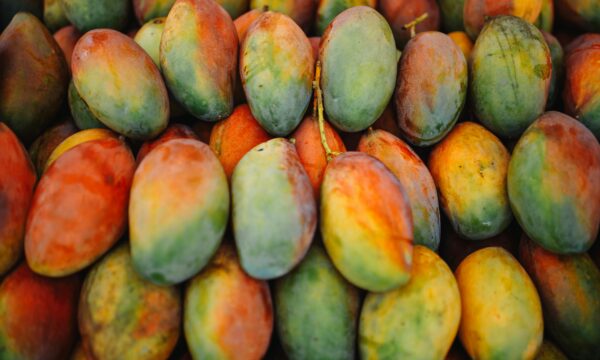
The coconut rhinoceros beetle has damaged many palm trees in Guam © Peter Lillywhite, Museum Victoria, Pests and Diseases Image Library (CC BY 3.0 license)
It takes a large combined effort to successfully eradicate a plant pest. The Guam Coconut Rhinoceros Beetle Eradication Project has finally found a technique that could bring them their own eradication success story. The coconut rhinoceros beetle (Oryctes rhinoceros) was first discovered in Guam on 11th September 2007. Over the past five years it has caused severe damage to coconut palms, although its initial spread was slowed by the quick reactions of the government. It is now present in many parts of the island and, as coconuts are an important economic commodity for the US territory, is high priority for removal.
The beetles, which are native to south and southeast Asia, have devastating effects on palm trees at each stage of their life cycle. The adults bore into the trees to breed; as they bore through the growing points of the trees, new leaves can’t be produced so the trees die. This provides plenty of dead palms for the beetle larvae to feed on, allowing the life cycle to continue.
Many different techniques have been tried out in an attempt to rid the island of these beetles but, until last year, were largely unsuccessful in making a negative impact on the rhinoceros beetle population. Quarantine restrictions have been enforced, legislating that inspection and/or treatment of green waste and plants is required before it can be transported from an infested to an uninfested part of the island. Most of the control efforts have focussed on actively killing the beetles in various ways. More than 1700 bucket traps were hung up in palm trees, containing pheromones to attract the beetles and designed so they couldn’t escape. These traps didn’t result in sufficient numbers being caught to control the population but did give an opportunity to monitor spread. Sanitation procedures have involved removing all beetles and grubs from their breeding sites and destroying all infested live and dead plant material. Use of pesticides such as methoprene and cypermethrin was also implemented but with little effect.
There have also been some more novel ideas to control the beetles. The Coconut Beetle Eradication Team set up a hotline (475-PEST) for members of the public to report incidences of the beetles, rewarding them with T-shirts as an incentive. The first biocontrol attempt was in 2008, when a USDA-APHIS grant was provided to release a virus, which occurs naturally in Malaysia, that would kill the beetles. This has been successful on other Pacific Islands that have suffered from invasions of the rhino beetle but, on Guam, the virus had little or no effect on the beetles. As control efforts weren’t working and the beetles continued to spread, in 2009 four detector dogs were brought in to sniff out the beetle breeding sites. An expert in audio detection of insects from the USDA also made audio recordings of beetle communication sounds to develop a method of detecting the invasive species using acoustic monitoring devices.
By last year, none of the measures taken had led to eradication of the rhino beetle. This was when a biocontrol technique developed by the Philippines Coconut Authority was employed. Spores of Metarhizium, also known as green muscardine fungus, were imported at the end of 2011. This fungus was chosen because it only affects the rhino beetles. Following lab tests, powder containing the spores was distributed to farmers to apply to infested palms. A process of autodissemination has also been implemented – dusting trapped male beetles, which are then released so that they spread the fungal spores to undiscovered breeding sites. This has already been shown to be taking effect: sites that have been treated and revisited have been found with dead or dying beetles, and grubs found at previously unknown and untreated sites have been found dead as a result of infection with the fungus. This gives a good indication that the autodissemination method is working.
The coconut rhinoceros beetle population of Guam is now on the decline. According to the Eradication Program operations chief, Roland Quitugua, damage to coconut trees that can be seen now occurred about six months ago, before the fungus was introduced, and residents of Guam should soon notice a reduction in the number of newly damaged trees. It has taken much investment of time and resources, plus a fair amount of trial and error, but the continued combined efforts of the authorities should mean that, in Guam, the coconut rhinoceros beetle’s days are numbered.
27 Comments
Leave a Reply
Related News & Blogs
Pest preparedness in action: Preventing the coconut hispine beetle invasion in Bangladesh
The coconut hispine beetle (Brontispa longissima) is a destructive pest of palms, including coconut palms. It is a major pest in Southeast Asia, the Pacific and parts of South Asia. For several years, Bangladesh has recognized the potential threat that…
2 June 2025






Are u freaking kidding! The Rhino Beattle rolled thru my yard in a matter of months. In 30 years there will be no palm trees on Guam. Calls to multiple sources have went unanswered. I tried everything but no luck. Will remove all the trees next week, what a shame. Not really Guams fault, just bad luck.
nice info but no cures talked about. Who has a trap and where can I see how to make them ? I have 4 dead in my yard this year and larvae all over.
[…] From Discovery to Eradication: The Coconut Rhinoceros Beetle on Guam by Abigail Rumsey […]
It really dosn’t look like the rhino beetle days are numbered? It looks like they are gaining more ground!
Need more attention and public awareness to address situation and ridding these disasterous pests! Guam leaders should be more involved, educate the public and organize teams/groups to get out there and chop/burn, fumigate all the above to rid of these nasty insects! Residents and concerned citizens should come together and stage an all out WAR against these bugs! There is the annual Coastal Cleanup, let’s start an Annual Rhino Beetle Eradication! Enlist the help from businesses, organizations, military off duty volunteers and concern citizens!
Imagine this, no more of these coconuts products (coconut wine TUBA, AHU, vinegar etc.) To lose this valuable tree will be a SHAME! Coconut trees are a part of the island culture and heritage! Let’s group and ACT NOW!!
Im in
Ted nelson says:
Your expert is dead wrong, from the start of last year I had no infestation, now my hundreds of coconut trees are being wiped out at my farm on the east side of guam. I’ve made many numerous attempts requesting for help and now it is to late. Grant funding over $1million dollars in the last 4 years to deal with the problem and there is no true answer. the experts ( commanders as they are titled) have stated to put moth balls or eat the larva like they do in the P.I. bottom line is they have to really do something soon and fast. Also, someone brought this to Guam I wish we can catch the culprit.
Did they leave those so called buckets in your area? Those buckets do not catch the beatles but attract those beetles to those areas! Refuse those buckets being put up in your private land! I’ve been driving around the island and saw nothing in those buckets?
I just want to know how to contact anybody and get my hands on this autodissemination dust so I can splatter them all over my property as I am now seeing damages to my coconut trees. I feel like getting a chainsaw and cutting all my infested trees down. I live in Chalan Okso, Wusstig Road, Dededo area and they are multiplying fast in this area. Someone please bring us some relief from these beetles!!!. Roland Quitugua and Aubrey Moore, I tried to call your office at 735-2086 but no one is answering. Is there another way to contact you folks? Thanks..
Hi Frank,
Roland and Aubrey are not involved in the Plantwise blog but I recommend asking your questions on the PestNet mailing list. I think Aubrey is a member of this group, and there are many others who may be able to help you: http://www.pestnet.org/HowtoJoinPestNet.aspx
Best wishes,
Abigail
The rhino beetle is out of control in Mangilao right behind the new payless. Just look at the coconut trees. Fred
Is there any new information regarding the control of this pest, or are the palm trees on Guam soon to be gone?
Hi Nancy,
I hope to write a follow-up article to this one as it is an issue that many people in Guam are worried about.
Best wishes,
Abbie
Reblogged this on norianntommy.
It got all my coconut trees also my other fan like palm trees as well. I’ve seen the holes on the trunks. I poured Dawn dishsoap on the top and on the holes that they drilled in… it appeared to be working with new leaves but..in 3 months it started looking bad again. My poor palm trees didnt have a chance. I HATE THESE STUPID BEETLES.
I was off island for a year. I just returned this year in January 2014 looking forward to coming home to our beautiful island and just now noticed so many coconut trees damaged by rhino beetle in the northern and central part of Guam! Me and my family even found rhino beetles in our garage, twice this year. I don’t think the eradication efforts is working.the rhino beetle on Guam is very much on the climb. More investments needed for customs to control and do a better job inspecting anything before it comes to our island. Our island will no longer be safe and beautiful for our children. We have rhino beetles, scorpions, black widows, and careless people that some how bring in dangerous animals/ reptiles such as boa constructors and piranhas? This is so stupid and should be strictly enforce!!!!! Our island is being neglected BY OUTSIDERS/ NON LOCALS AND by allowing this to happen! We need to need to do a better job protecting our island our future our CHILDREN!!!!!!!!!!!
LBJ elementary school trees on the beach side infested .
where to get fungus or anything to kill the larvae. Lots of web sites explaining but no help on where to get chemicals, fungus or do anything about it. research on cause; ok so what if no assistance on where to go to buy anything. My trees are dying one by one. I”ll try anything. grow anything. My neighbors trees closest being hit also.
You may try spreading PHORATE granules 5gms mixed in 20gms of fine sand over the tender spud leave and around the gaps once on 15 days. Also try to hang in small smoth cloths Naphalene balls above the base of the tender leave 4 to 6 such pieces around the tree. This will discourage the beetle to settle on the tree.
Diatomaceous earth should kill the larvae.. Non toxic too
Even my foxtails and champagne trees being killed
[…] management techniques have been attempted on Guam since 2007. In March 2012, the Plantwise Knowledge bank reported on a promising new biological control method, the Metarhizium fungus. The fungus is specific to rhino beetles and the CRB-Guam biotype appeared […]
[…] management techniques have been attempted on Guam since 2007. In March 2012, the Plantwise Knowledge bank reported on a promising new biological control method, the Metarhizium fungus. The fungus is specific to rhino beetles and the CRB-Guam biotype appeared […]
Roughly how long does a tree take to die once infected ?
[…] From discovery to eradication: the coconut rhinoceros beetle on GuamIn “Crop losses” […]
[…] From discovery to eradication: the coconut rhinoceros beetle on Guam (2012) […]
https://www.horticulture.com.au/globalassets/hort-innovation/resource-assets/ny15002-scarab-beetle-factsheet.pdf